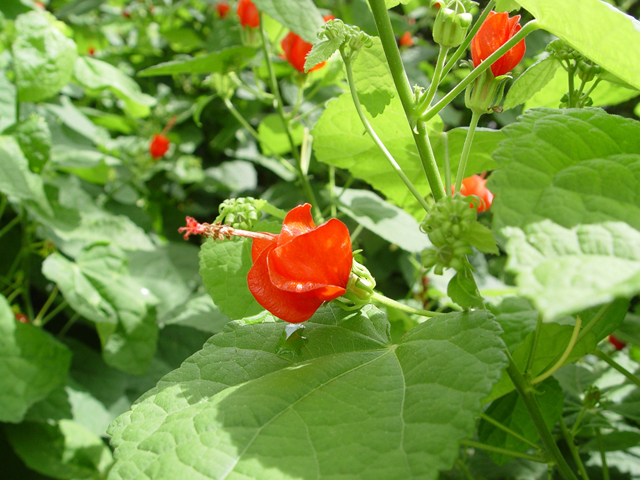
Malvaviscus arboreus
This plant’s bright red flowers can be seen popping up all over Covington through most of the summer and even into fall. The small, hibiscus-like flowers never fully open, their petals overlapping to form a loose tube with the staminal column protruding. It is said to resemble a Turkish turban, hence its most common name Turk’s Cap, but it is also referred to as the Wax Mallow, Bleeding Hearts, Sleeping Hibiscus, or Mexican Apple. It likes shady places, especially along rivers and creeks, making Covington an ideal home for this cheery wild shrub.

Turk’s Cap is a member of the Mallow family (family Malvaceae), which includes herbs, shrubs, and rarely small trees. There are about 85 genera and 1,500 species, many in tropical America. Okra, hibiscus and the cotton plant are also in this family.
Most Turk’s Cap that we see here are native varieties, though other varieties have been introduced to the region. Turk’s Cap has also been introduced to Hawaii, Puerto Rico & the Virgin Islands.

One native variation drummondii, or Drummond’s Turk’s Cap, is named for Thomas Drummond, (ca. 1790-1835), a Scottish naturalist who in the 1830’s spent twenty-one months working the area between Galveston Island and the Edwards Plateau, especially along the Brazos, Colorado, and Guadalupe rivers. He collected 750 species of plants and 150 specimens of birds. His collections were the first in Texas that were extensively distributed among the museums and scientific institutions of the world.
Like hibiscus, the flower and fruit of Turk’s Cap are edible and can be made into tea. The long, cylindrical shape of the flower makes it perfect for butterflies, moths and hummingbirds. Birds and small mammal will also feast on it’s fruit.
The hardiness of this perennial shrub makes it an ideal addition to gardens! It is drought resistant and will over-winter outdoors in our climate.

Here are some links to websites I used for this article:
https://www.wildflower.org/plants/result.php?id_plant=maar14
https://www.wildflower.org/plants/result.php?id_plant=MAARD
https://www.uaex.edu/yard-garden/resource-library/plant-week/mallow_turks_cap_11-1-13.aspx



